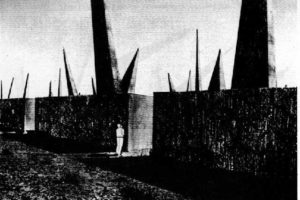10,000 Year Danger Marker?
Here’s a real-world puzzle for students of precautionary cognition.
The US Department of Energy’s “Waste Isolation Pilot Plan” is a program to store nuclear waste in an area that will remain toxic to humans for at least 10,000 years. The planners need to place markers that will discourage vandalism and reliably convey danger for 400 generations.
The Edvard Munch aspect of the image above seems promising, but English text?
They also considered planting immense spikes to inspire awe as well as aversion:
Ouch.
To explore some of the options the planners have considered, see here [http://downlode.org/Etext/WIPP/].
What would you propose?
2 Comments
You must be logged in to post a comment.



Olivier Morin 19 March 2009 (10:53)
Thanks Colin ! that’s a real puzzle. In my view, the current projects, e.g. the spikes, look like invitations for archeologists of the future to dig just there. The great tombs of the Ancients, the pyramids, etc. were all suposed to inspire awe and to deter scavengers from entering… They also bore fear-inspiring signs. Of course that’s the kind of things that makes you want to get inside and dig for gold. The best option, in my view, would be no sign at all: no pikes, no sign, no landmark, and leave the place to oblivion. There probably won’t be a human race by that time anyway.
Colin Holbrook 19 March 2009 (16:29)
Olivier makes an excellent point- one which I do not believe has been considered by the planning team. However, in the excerpts document linked to above, there is some discussion of the costs of erecting mammoth/enduring warning structures versus doing nothing and letting the death and disease associated with the site speak for itself. While on the face of it, that option sounds quite inhuman, it may be the most effective course, in part for the reasons cited by Olivier.